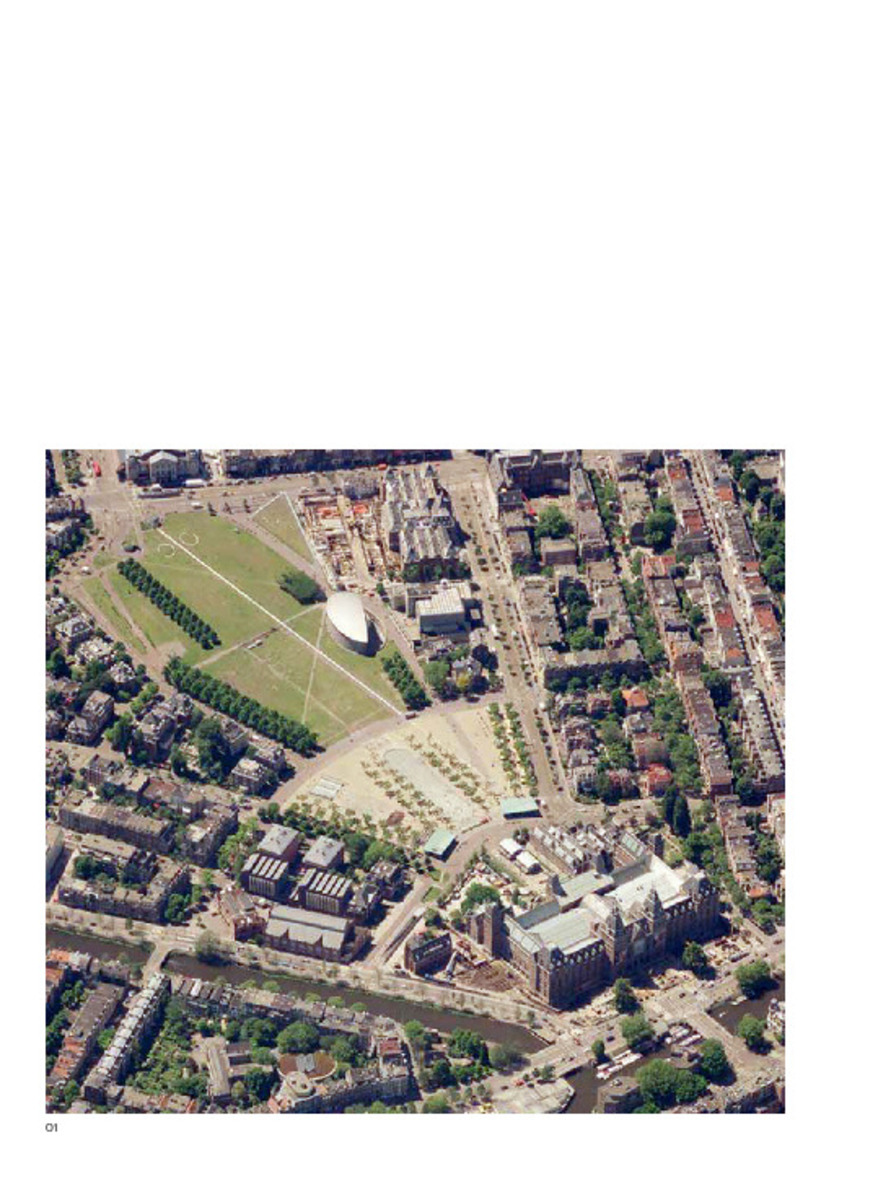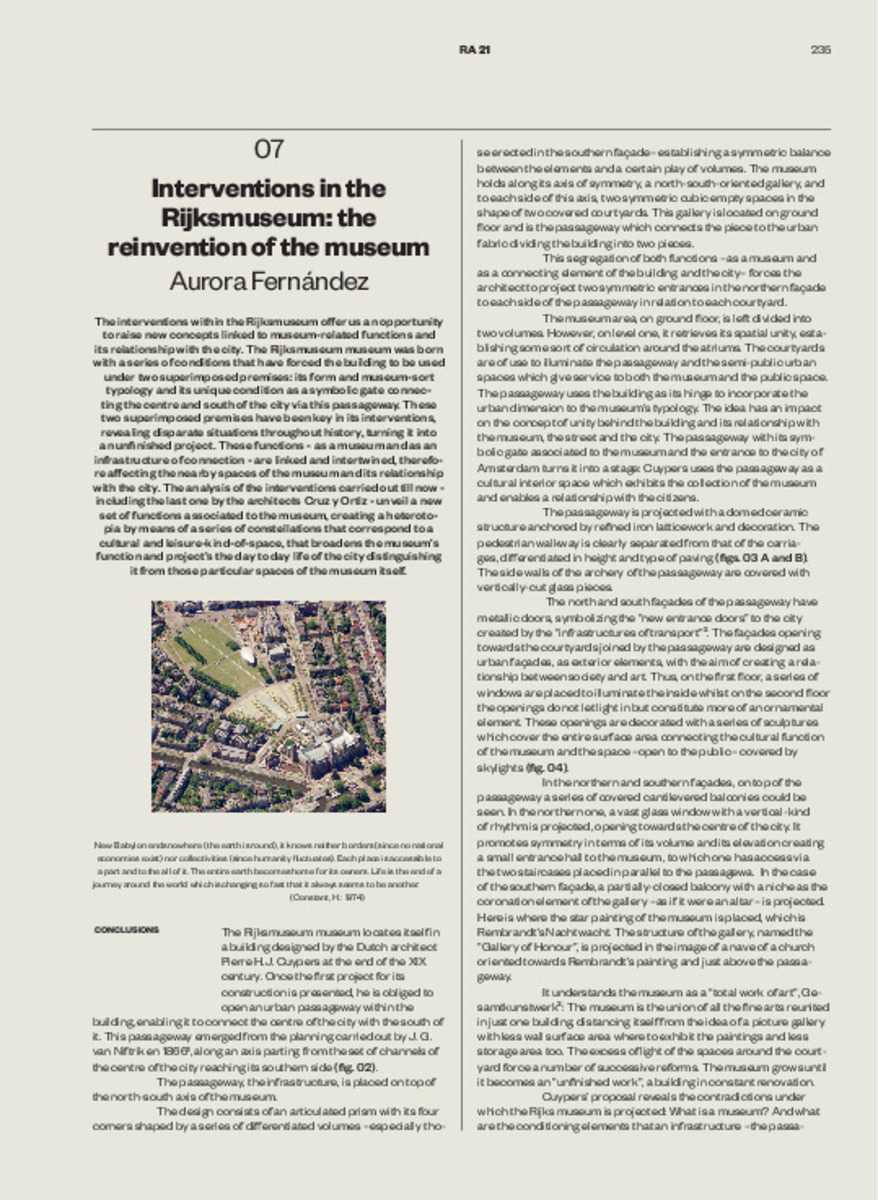Registro completo de metadatos
| Campo DC | Valor | Lengua/Idioma |
|---|---|---|
| dc.creator | Fernández, A. (Aurora) | - |
| dc.date.accessioned | 2019-10-08 | - |
| dc.date.accessioned | 2021-06-23T08:37:24Z | - |
| dc.date.available | 2021-06-23T08:37:24Z | - |
| dc.date.issued | 2019 | - |
| dc.identifier.citation | Fernández, A. (Aurora). "Intervenciones en el Rijksmuseum: la reinvención del museo". Ra. Revista de Arquitectura. 21, 2019, 84 - 95 | es |
| dc.identifier.issn | 1138-5596 | - |
| dc.identifier.uri | https://hdl.handle.net/10171/60774 | - |
| dc.description.abstract | The interventions within the Rijksmuseum offer us an opportunity to raise new concepts linked to museum-related functions and its relationship with the city. The Rijksmuseum museum was born with a series of conditions that have forced the building to be used under two superimposed premises: its form and museum-sort typology and its unique condition as a symbolic gate connecting the centre and south of the city via this passageway. These two superimposed premises have been key in its interventions, revealing disparate situations throughout history, turning it into an unfinished project. These functions - as a museum and as an infrastructure of connection - are linked and intertwined, therefore affecting the nearby spaces of the museum and its relationship with the city. The analysis of the interventions carried out till now - including the last one by the architects Cruz y Ortiz - unveil a new set of functions associated to the museum, creating a heterotopia by means of a series of constellations that correspond to a cultural and leisure-kind-of-space, that broadens the museum’s function and project’s the day to day life of the city distinguishing it from those particular spaces of the museum itself. | en_US |
| dc.description.abstract | Las intervenciones en el Rijksmuseum nos ofrecen una oportunidad para plantear nuevos conceptos asociados a la función museística y de relación con la ciudad. El Rijksmuseum nace con unas condiciones que han obligado a usar el edificio con dos premisas superpuestas su forma y tipología de museo y su condición de edificio-puerta, a través del pasaje, de conexión del centro y el sur de la ciudad. Estas dos premisas superpuestas han sido clave en sus intervenciones, revelando situaciones dispares a lo largo de la historia, que lo han convertido en un proyecto inacabado. Estas funciones, museo e infraestructura de conexión, están ligadas y entrelazadas y afectan a los espacios del museo y su relación con la ciudad. Del análisis hasta la última intervención de los arquitectos Cruz y Ortiz, nos revelan nuevas funciones asociadas al museo generando una heterotopía mediante un conjunto de constelaciones que se corresponden con un espacio cultural y de ocio que amplía la función museo y proyecta lo cotidiano de la ciudad que lo distingue de los espacios propios de museo. | es_ES |
| dc.language.iso | spa | - |
| dc.publisher | Servicio de Publicaciones de la Universidad de Navarra | es_ES |
| dc.rights | info:eu-repo/semantics/openAccess | es_ES |
| dc.subject | Rijksmuseum | - |
| dc.subject | rehabilitación | - |
| dc.subject | Cuypers | - |
| dc.subject | Cruz y Ortiz | - |
| dc.subject | pasaje | - |
| dc.subject | ciudad | - |
| dc.subject | heterotopía | - |
| dc.title | Intervenciones en el Rijksmuseum: la reinvención del museo | es_ES |
| dc.title.alternative | Interventions in the Rijksmuseum: the reinvention of the museum | en_US |
| dc.type | info:eu-repo/semantics/article | es_ES |
| dc.identifier.doi | 10.15581/014.21.84-95 | - |
| dadun.citation.endingPage | 95 | - |
| dadun.citation.publicationName | Ra. Revista de Arquitectura | - |
| dadun.citation.startingPage | 84 | - |
| dadun.citation.volume | 21 | - |
Ficheros en este ítem:
Estadísticas e impacto
Los ítems de Dadun están protegidos por copyright, con todos los derechos reservados, a menos que se indique lo contrario.







